Spangled coquette
The spangled coquette, coquette pailletée (French), coqueta coronada, or coqueta lentejuelada (both Spanish) (Lophornis stictolophus) is a species of hummingbird in the "coquettes", tribe Lesbiini of subfamily Lesbiinae. It is found in Brazil, Colombia, Ecuador, Peru, and Venezuela.[3][4][5]
| Spangled coquette | |
|---|---|
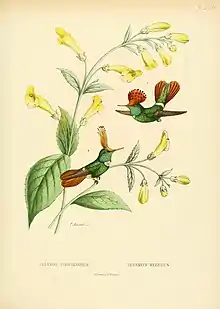 | |
| Male, on the left | |
| Scientific classification | |
| Domain: | Eukaryota |
| Kingdom: | Animalia |
| Phylum: | Chordata |
| Clade: | Dinosauria |
| Class: | Aves |
| Clade: | Strisores |
| Order: | Apodiformes |
| Family: | Trochilidae |
| Genus: | Lophornis |
| Species: | L. stictolophus |
| Binomial name | |
| Lophornis stictolophus | |
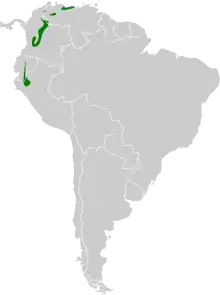 | |
Taxonomy and systematics
The spangled coquette is believed to be most closely related to the short-crested coquette (L. brachylophus) and rufous-crested coquette (L. delattrei).[6] It is monotypic.[3]
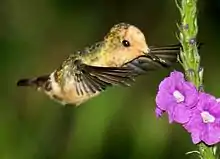
Description
The spangled coquette is 6.4 to 6.9 cm (2.5 to 2.7 in) long. Both sexes have a short, straight, red bill with a black tip and bronzy green upperparts with a white band across the rump. Their lower rump and uppertail coverts are purplish bronze. Adult males have a short, bushy, rufous crest with black tips on the feathers, and short rufous and iridescent green cheek tufts. Its throat is iridescent green with a few white-tipped feathers and the rest of the underparts bronzy green. Its central tail feathers are green and the rest cinnamon-rufous with black tips. The adult female does not have the male's crest or cheek tufts. It has a whitish throat with large rufous spots. It underparts are cinnamon, often with green spots. The central tail feathers are green and the rest are cinnamon with black bars near the end and buff tips. Juveniles are similar to the adult female but have a grayish throat.[6]
Distribution and habitat
According to the International Ornithological Committee (IOC) and Clements taxonomy, the spangled coquette is found from western Venezuela south through eastern Colombia and Ecuador into northern Peru.[3][7] The South American Classification Committee of the American Ornithological Society (SACC) places it in Brazil as well.[5] It inhabits the edges and clearings of humid forest, cerrado, and drier scrubby landscapes. In elevation it is found as high as 1,300 m (4,300 ft).[6]
Behavior
Movement
The spangled coquette is sedentary.[6]
Feeding
The spangled coquette feeds on the nectar of a variety of flowering plants, typically at tree-top level, though details of its diet are lacking. It "steals" nectar from the territories of larger hummingbirds. It catches arthropods by hawking from a perch.[6]
Vocal and non-vocal sounds
The spangled coquette is mostly silent. It gives "a high, sharp 'tsip'" while feeding. Its wings make "a low bee-like humming" when hovering.[6]
Status
The IUCN originally assessed the spangled coquette as Near Threatened but since 2004 has rated it as being of Least Concern. Its population size and trend are not known.[1] It is "[g]enerally rare, but no immediate threats recorded so far" and appears to accept some human-made habitats.[6]
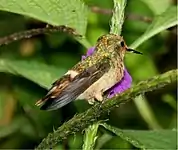 Copalinga Lodge, Ecuador / flash photo
Copalinga Lodge, Ecuador / flash photo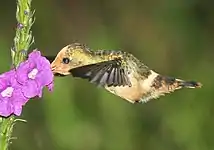 Copalinga Lodge, Ecuador / flash photo
Copalinga Lodge, Ecuador / flash photo
References
- BirdLife International (2016). "Spangled Coquette Lophornis stictolophus". IUCN Red List of Threatened Species. 2016: e.T22687211A93145065. doi:10.2305/IUCN.UK.2016-3.RLTS.T22687211A93145065.en. Retrieved 25 January 2022.
- "Appendices | CITES". cites.org. Retrieved 2022-01-14.
- Gill, F.; Donsker, D.; Rasmussen, P., eds. (January 2022). "Hummingbirds". IOC World Bird List. v 12.1. Retrieved January 15, 2022.
- HBW and BirdLife International (2020) Handbook of the Birds of the World and BirdLife International digital checklist of the birds of the world Version 5. Available at: http://datazone.birdlife.org/userfiles/file/Species/Taxonomy/HBW-BirdLife_Checklist_v5_Dec20.zip [.xls zipped 1 MB] retrieved May 27, 2021
- Remsen, J. V., Jr., J. I. Areta, E. Bonaccorso, S. Claramunt, A. Jaramillo, D. F. Lane, J. F. Pacheco, M. B. Robbins, F. G. Stiles, and K. J. Zimmer. Version 24 August 2021. Species Lists of Birds for South American Countries and Territories. https://www.museum.lsu.edu/~Remsen/SACCCountryLists.htm retrieved August 24, 2021
- Züchner, T. and P. F. D. Boesman (2020). Spangled Coquette (Lophornis stictolophus), version 1.0. In Birds of the World (J. del Hoyo, A. Elliott, J. Sargatal, D. A. Christie, and E. de Juana, Editors). Cornell Lab of Ornithology, Ithaca, NY, USA. https://doi.org/10.2173/bow.spacoq1.01 retrieved January 25, 2022
- Clements, J. F., T. S. Schulenberg, M. J. Iliff, S. M. Billerman, T. A. Fredericks, J. A. Gerbracht, D. Lepage, B. L. Sullivan, and C. L. Wood. 2021. The eBird/Clements checklist of Birds of the World: v2021. Downloaded from https://www.birds.cornell.edu/clementschecklist/download/ Retrieved August 25, 2021
